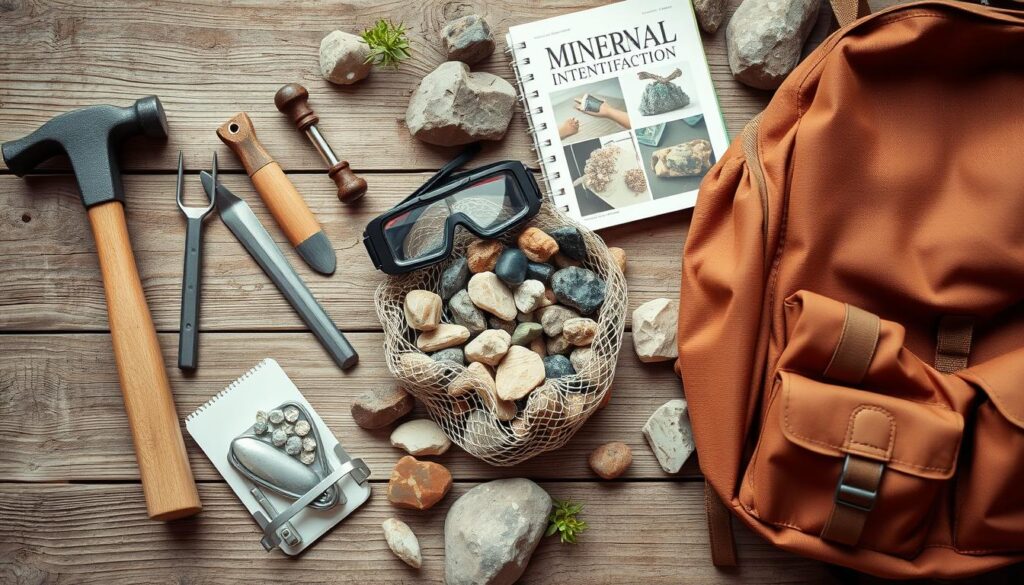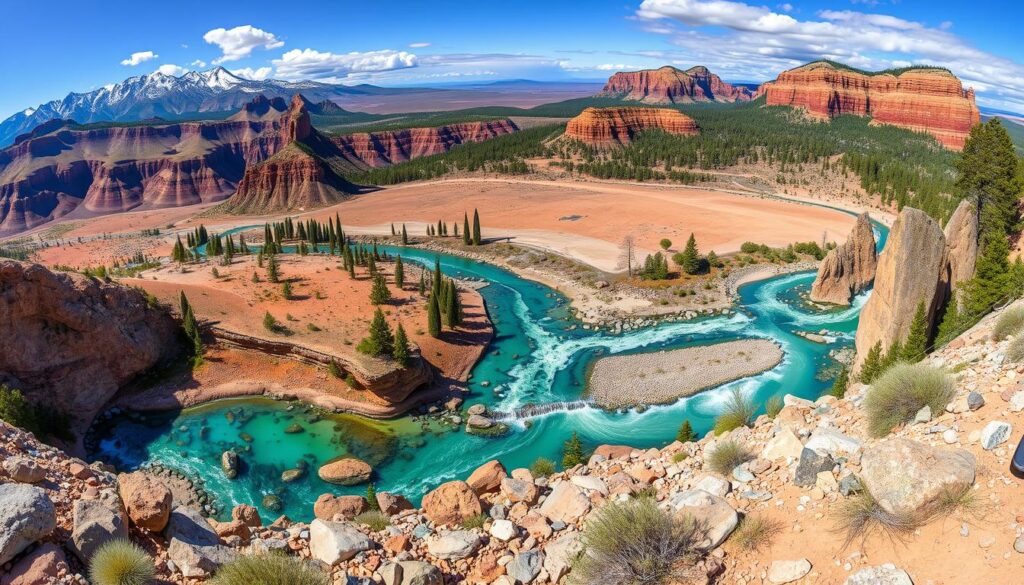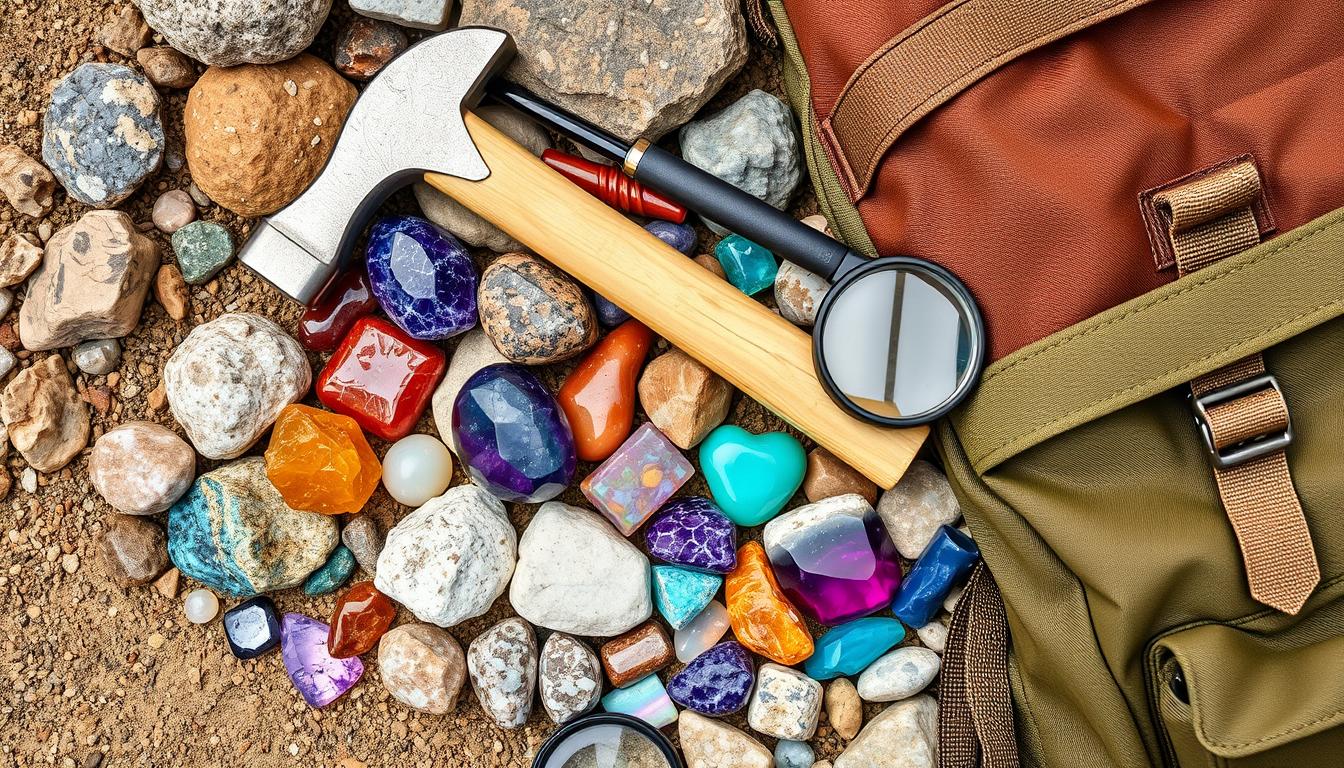This post contains affiliate links.
Ever dreamed of finding a shiny gemstone or a rare fossil? Rock hounding might be your dream come true. It’s a mix of treasure hunting and geology, letting you connect with nature and history.
Rock hounding is more than just collecting pretty rocks. It’s a trip back in time, where each rock has a story to tell. The US, from Arizona’s deserts to Oregon’s coasts, is full of places for rock hunters.
Rock hounding appeals to many, whether it’s crystals, gemstones, or fossils. It takes you on adventures from mountains to deserts, promising new discoveries at every turn.
Starting your rock hounding journey means learning to read the landscape and understand geology. You might find pieces of Earth’s history that few have seen. Are you ready to dive into rock hounding and find hidden treasures?
Key Takeaways
- Rock hounding combines adventure and geological exploration
- The US offers diverse locations for finding various minerals and gems
- Basic tools and knowledge are essential for successful rock hunting
- Understanding local laws and regulations is crucial for responsible collecting
- Rock hounding can lead to discovering rare and valuable geological specimens
Understanding Rock Hounding: A Beginner’s Introduction
Rock hounding is a fun hobby that mixes the excitement of finding treasures with learning about geology. It’s not just about collecting rocks; it’s an adventure that takes you into nature’s secret spots. Rockhounding basics mean searching for rocks, minerals, fossils, and gemstones in their natural places.
The Unique Charm of Rock Hounding
Rock hounding is different from regular collecting because it takes you outside. You’ll explore far-off places with special tools. You might hike, dig, or even crawl to find your treasures. It’s a hands-on way to learn about Earth’s history and how it works.
A Brief History
Rock hounding started with early geological exploration and mining. Now, it’s a favorite hobby that mixes science with fun. Places like Michigan, Montana, and Idaho are great for finding collectible rocks and gems.
Essential Terms for Beginners
To start with rock collecting, learn these key terms:
- Agate: A banded form of chalcedony
- Geode: A hollow rock filled with crystals
- Placer mining: Searching for minerals in stream deposits
- Lapidary: The art of cutting and polishing stones
Knowing these basics will make your amateur geology adventures better. Remember, rock hounding is an exciting hobby that lets you find hidden treasures while learning about the Earth beneath our feet.
| Activity | Cost | Benefit |
|---|---|---|
| Pay-to-Dig Sites | $5-50 per day | Access to mine tailings or pits |
| Club Excursions | Membership fees vary | Group trips to authorized sites |
| Public Land Digging | Free | Open access to National Forests and BLM land |
As you start rock hounding, you’ll find it’s a fun, affordable activity for families. It helps reinforce geology lessons from school. With patience and practice, you’ll learn to identify rocks and show off your finds in polished displays.
Essential Tools and Equipment for Success
Starting a rockhounding adventure means you need the right gear. Having the right rockhounding tools is key to success. Let’s look at the essential items for your next adventure.

A good rock hammer is the heart of any rockhound’s kit. It should weigh 2 to 4 pounds. This size is perfect for cracking open rocks and finding hidden treasures. Use a pry bar, 18″ to 22″ long, for moving bigger rocks.
Your collecting bag is vital for keeping your finds safe. Choose a strong canvas bag with pockets. It helps keep your specimens organized. Also, remember to bring wrapping materials like newspaper or fabric to protect fragile pieces.
Don’t forget about safety gear. Wear gloves, protective eyewear, and sturdy boots. The Salomon Quest 4D 3 GTX Boots are great for uneven terrain. They help you stay steady while searching.
Additional Equipment for the Savvy Rockhound
- Full-size shovel for surface work
- Picks and trowels for precise digging
- Magnifying glass (10x magnification) for detailed examination
- Spray bottle with water for cleaning samples
- Field guide for on-the-spot identification
When exploring remote areas, bring extra supplies. Pack a first-aid kit, enough water, and food. A GPS device or compass is also important for safe navigation.
| Tool | Purpose | Recommended Spec |
|---|---|---|
| Rock Hammer | Breaking rocks | 2-4 lbs weight |
| Pry Bar | Moving heavy specimens | 18″-22″ length |
| Collecting Bag | Storing finds | Sturdy canvas with compartments |
| Safety Glasses | Eye protection | ANSI Z87.1 certified |
| Boots | Foot protection and traction | Waterproof with grip soles |
Having the right tools is crucial for a successful rockhounding journey. Invest in quality gear to improve your experience and find amazing specimens.
Laws and Regulations for Rock Hunters
It’s important to know the rockhounding laws and public land regulations. The Bureau of Land Management (BLM) manages 245 million surface acres in the U.S. Most of these lands allow rockhounding. Knowing these rules makes your adventure fun and legal.
Federal Land Guidelines
On BLM lands, you can collect up to 25 pounds of rocks per day. The yearly limit is 250 pounds. This is for personal use only. The U.S. Forest Service has similar rules, but always check local restrictions. National parks and monuments are off-limits for collecting.
State Park Regulations
State parks have different rules for rock hunting. Some need collecting permits, while others limit how much you can collect. It’s a good idea to contact the park office before you go. In Arizona, for example, BLM allows up to 25 pounds of rocks per day on public lands.
Private Property Considerations
Always get permission before rockhounding on private land. Respect property rights and leave no trace. About 70% of rock hounds research locations before their trips, showing the importance of preparation.
Remember, collecting Indian artifacts or vertebrate fossils on public lands is prohibited without proper permits. Stay safe, follow the rules, and enjoy your rockhounding adventures!
| Location | Daily Limit | Annual Limit | Special Notes |
|---|---|---|---|
| BLM Lands | 25 pounds | 250 pounds | Personal use only |
| National Parks | No collection | No collection | Strictly prohibited |
| State Parks | Varies | Varies | Check local regulations |
| Private Property | Owner discretion | Owner discretion | Permission required |
Best Locations for Rock Hounding in the United States
The United States has many different landscapes perfect for rockhounding. You can find treasures from beaches to mountains, and from deserts to forests. Let’s look at some of the best places to rockhound in the country.

Oregon’s coastline is a top spot for rock hunters. Its beaches are full of agates, jasper, and sunstone, Oregon’s official gem. Utah’s Thomas Range is known for topaz, and the desert has red beryl and geodes.
Arizona is a dream for rockhounds, with its turquoise, fire agate, and quartz crystals. These places show off Arizona’s rich mineral history. The Appalachian Mountains and Pacific Northwest are also great for finding minerals.
| State | Notable Minerals | Popular Locations |
|---|---|---|
| Oregon | Agates, Jasper, Sunstone | Coastal beaches, Sunstone Public Collection Area |
| Utah | Topaz, Red Beryl, Geodes | Thomas Range, Topaz Mountain |
| Arizona | Turquoise, Fire Agate, Quartz | Morenci Mine area, Saddle Mountain |
Before you go rockhounding, check the local laws and rules. Wear comfy shoes, protect yourself from the sun, and bring a rock hammer and hand lens. Have fun hunting!
Identifying Common Rocks, Minerals, and Gemstones
Rock hounding success comes from knowing how to identify different specimens. This skill is key for mineral identification and learning about gemstones. Let’s dive into the important parts of this exciting process.
Physical Properties and Testing Methods
To spot rocks and minerals, look at their physical traits. Color, shine, streak, and crystal shape matter a lot. The Mohs hardness scale is a big help. It goes from 1 (softest) to 10 (hardest).
| Mineral | Mohs Hardness | Notable Properties |
|---|---|---|
| Agate | 7 | Banded appearance |
| Amazonite | 6-6.5 | Bluish-green color |
| Amethyst | 7 | Purple crystalline quartz |
| Diamond | 10 | Formed under extreme conditions |
Common Types of Specimens
You’ll find many rock types on your adventures. Igneous rocks like granite and basalt, sedimentary rocks like limestone and shale, and metamorphic rocks like marble are common. Gemstones like aquamarine and citrine make your hunts more exciting.
Using Field Guides and Resources
A good rock and mineral guide is crucial for correct identification. The Peterson Field Guide to Rocks and Minerals and the Smithsonian Handbooks: Rocks & Minerals are great resources. For those who love tech, mobile apps can be useful in the field.
Remember, the more you practice, the better you’ll get at identifying minerals. The more specimens you study, the more you’ll know about unique gemstone properties. Happy rock hounding!
Rock Hunting Techniques and Strategies
Learning rockhounding methods is crucial for finding gems and minerals. Techniques like surface collecting, digging, and sluicing can help you find hidden treasures. When searching for crystals, look for geodes and vugs in volcanic rocks.
Riverbeds and beaches are great places to search, focusing on gravel bars and slow-moving water areas.
Old mine tailings are often overlooked but can be rich in minerals. Geological maps are key for finding good spots based on rock types. Timing is important too. Go after storms or during low tides for the best finds.
- Pay-to-dig sites charge $5-50 per day for access to tailings or pits
- Public lands like National Forests and BLM areas are often open for collecting
- Local clubs organize group excursions to authorized sites
- Reference books provide detailed directions and mineral information
Develop a systematic way to search and keep track of where you find things. This helps you plan future trips. Rockhounding gets better with time. Many experts spend years perfecting their skills.
“Rockhounding offers insights into Earth’s history and fosters the study of crystal and mineral formations.”
Get the right tools for the job. Use rock hammers for softer rocks and pickaxes for harder ones. Always wear safety gear like eye protection, gloves, and sturdy boots. With patience and the right strategies, you’ll find amazing geological wonders soon.
Safety Measures and Best Practices
Rockhounding safety is key for a fun and safe outdoor trip. You need to be ready and know the risks.
Essential Safety Equipment
When rock hunting, wear the right gear to stay safe. Choose sturdy boots for your ankles and gloves for your hands. Don’t forget eye protection, like goggles, when you break rocks. If you’re near cliffs or caves, a helmet is a must.
Weather Considerations
Weather is important for outdoor safety. Always check the forecast and wear layers. In winter, watch out for hidden rocks and slippery paths. Start early because days are shorter, and bring a headlamp.
Emergency Preparedness
Being ready for emergencies is crucial. Carry a first-aid kit, water, and emergency supplies. Let someone know where you’re going and when you’ll return. Learn basic survival skills and how to use a map and compass. Be careful of unstable ground and wildlife.
Remember, rock tumbling and polishing can be rewarding after collecting rocks. But safety is always first.
| Essential Item | Purpose |
|---|---|
| Sturdy Boots | Ankle protection and grip |
| Gloves | Hand protection |
| Safety Goggles | Eye protection |
| First-Aid Kit | Emergency care |
| Water | Hydration |
Preserving and Displaying Your Finds
After your exciting rock hounding adventures, it’s time to focus on preserving and showcasing your treasures. Proper mineral cleaning, rock storage, and specimen display techniques are essential for maintaining the beauty and integrity of your collection.
Cleaning Methods
Gentle mineral cleaning is crucial for preserving your finds. Start with water and soft brushes for most specimens. For tougher cleaning jobs, use diluted muriatic acid with caution. Always wear protective gear and work in a well-ventilated area when using chemicals.
Storage Solutions
Effective rock storage prevents damage to your specimens. Use padded containers or compartmentalized boxes to keep items separate. Label each find with its location and date. This practice not only organizes your collection but also enhances its scientific and personal value.
Display Ideas
Create stunning specimen displays to showcase your rock hounding treasures. Glass cabinets, custom-built shelves, or acrylic stands are popular choices. Proper lighting is key to highlighting the unique features of minerals and gemstones. Consider creating themed displays or educational exhibits to share your passion with others.
| Display Type | Advantages | Best For |
|---|---|---|
| Glass Cabinets | Dust protection, visibility | Delicate specimens, rare finds |
| Custom Shelves | Flexibility, personalization | Large collections, varied sizes |
| Acrylic Stands | Clarity, individual focus | Prized specimens, small gems |
Remember to protect delicate specimens from direct sunlight and excessive humidity. With proper care, your rock collection can last for generations, providing endless enjoyment and learning opportunities. For more tips on rock hounding and preservation, check out this comprehensive guide to Utah rock hounding.
Conclusion
Starting the rock hounding hobby opens a door to exploring geology and amateur mineralogy. You’ll dive into a world filled with hidden treasures. Every find, from giant Herkimer Diamonds to garnets in Connecticut schist, is exciting.
The tools and clothes for rockhounding haven’t changed much in 50 years. Yet, the experience remains as fresh as ever. Whether you join a club or go solo, the community welcomes you. You can practice on public lands or pay sites, with costs from $5 to $50 a day.
As you explore this hobby, get educated. Books and guides are key for beginners. They teach you to identify minerals and find the best spots. Rockhounding is not just about collecting. It’s about connecting with nature and others, creating lasting wonder.
FAQ
What is rock hounding?
What tools do I need for rock hounding?
Are there laws regulating rock hounding?
What are some top rock hounding locations in the U.S.?
How do I identify rocks and minerals?
What safety precautions should I take when rock hounding?
How should I clean and preserve my finds?
What is lapidary?
Can I go fossil hunting as part of rock hounding?
What is the difference between rock hounding and gemstone prospecting?
This post contains affiliate links.

